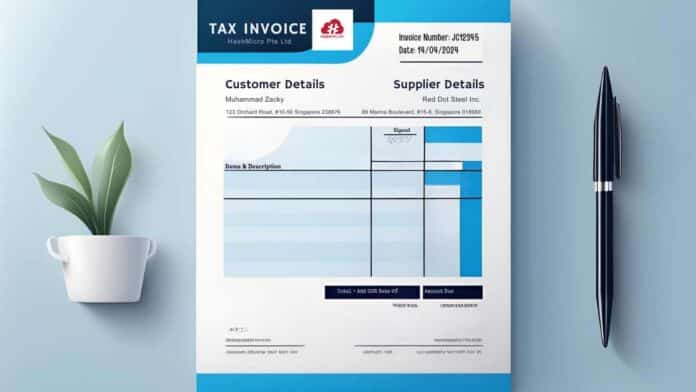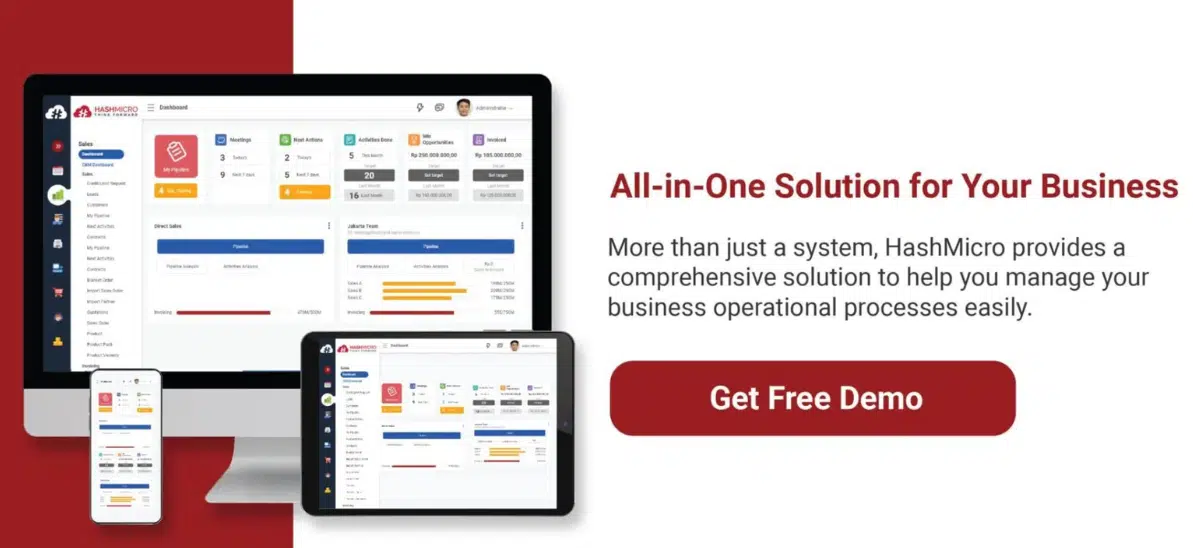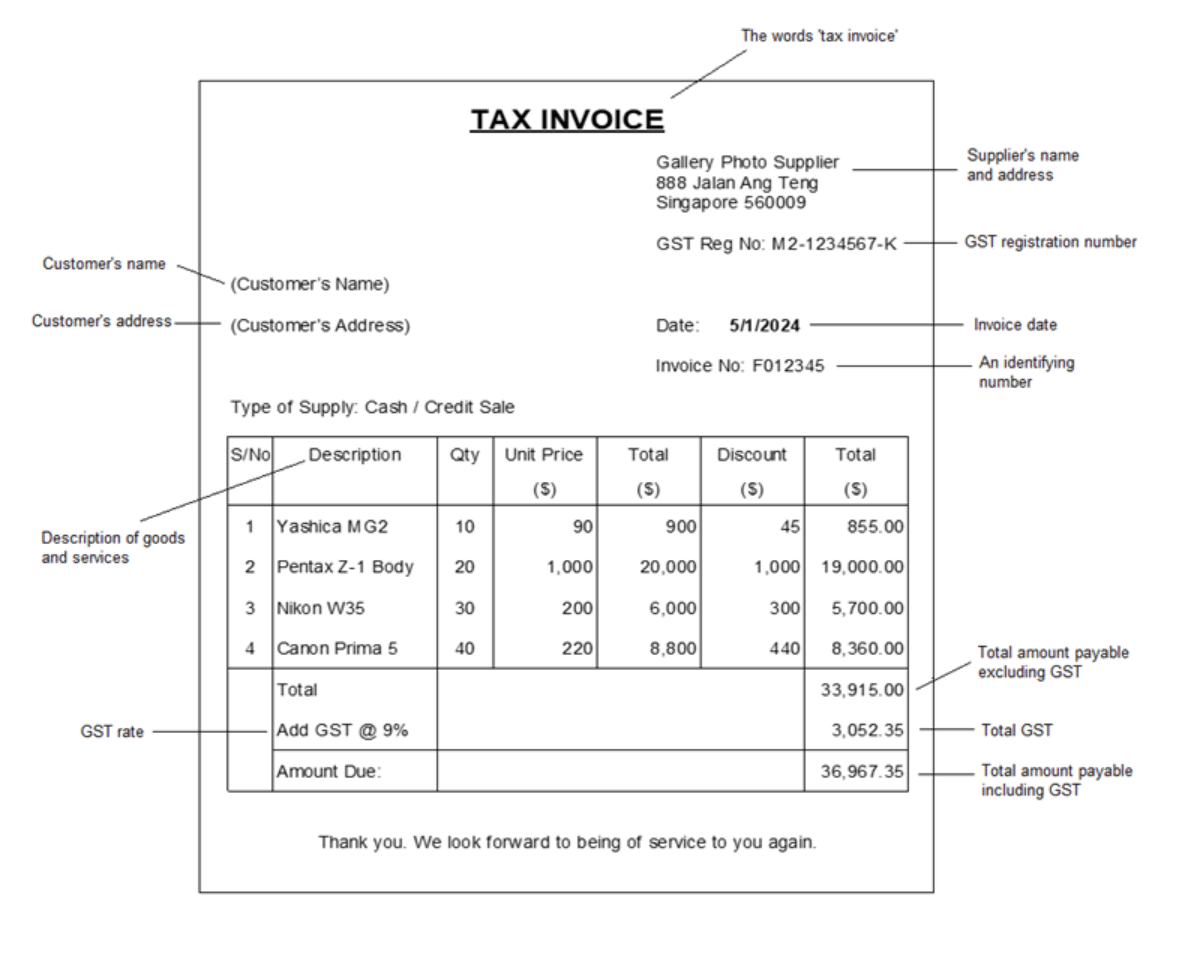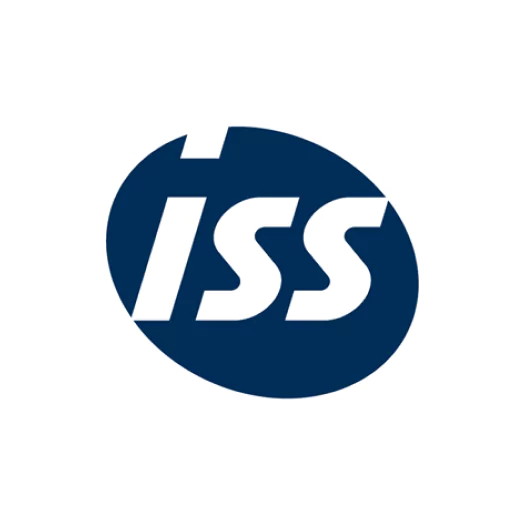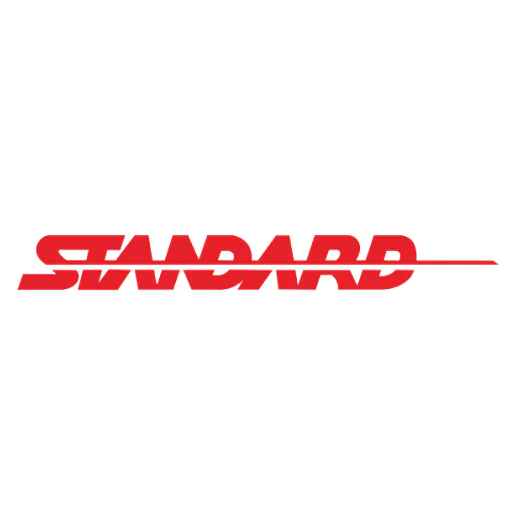Tax invoices are more than just proof of tax payment; they are crucial for businesses to stay compliant with Singapore’s tax regulations. They break down taxable and non-taxable amounts, helping companies claim input tax credits under the GST system and maintain transparent records for audits.
Issuing tax invoices requires attention to detail, with challenges like incomplete information when doing invoice input, 30 days timing issues, and evolving regulations. Fortunately, businesses can now use ready-made tax invoice templates, and among them is a hidden gem.
Imagine creating invoices effortlessly with personalized templates for each client, eliminating manual calculations. Enter best e-Invoicing Software, designed to streamline your invoicing process.
This software automatically calculates taxes and discounts, making invoicing smoother and more efficient. Ready to make invoicing simpler? Keep reading to learn more!
Table of Content:
Table of Content
Key Takeaways
|
What is the Tax Invoice Template?
A Tax Invoice Template is a pre-designed document that businesses use to issue invoices while ensuring compliance with tax regulations. It includes all necessary fields, such as the business details, invoice number, date, description of goods or services, and the breakdown of taxable and non-taxable amounts.
These templates help businesses create consistent, accurate invoices every time, reducing the risk of errors and improving efficiency. In Singapore, where compliance with GST regulations is critical, using a Tax Invoice Template ensures that all required information is captured correctly.
This simplifies the process of claiming input tax credits and facilitates smooth financial audits. With customizable options, businesses can tailor these templates to suit their specific needs, whether for different clients or types of transactions.
By using a Tax Invoice Template, companies not only save time but also stay on top of regulatory requirements, ensuring smooth operations and reducing the likelihood of costly mistakes.
What are the Requirements of Tax Invoice?
A tax invoice is an essential document that ensures compliance with GST regulations and provides clarity to both businesses and customers. Let’s break down its key requirements to make it easier for you to issue one confidently:
- The Words “Tax Invoice”
Begin your document with a clear title—”Tax Invoice”—so its purpose is immediately recognized. - Supplier’s Details
Include your business name, address, and GST registration number. This information helps establish your business credibility and ensures compliance. - Customer’s Details
Clearly mention your customer’s name and address. This creates transparency and makes the invoice personalized. - Invoice Number and Date
Assign a unique identifying number to every invoice and include the date it was issued. This ensures easy tracking for both parties. - Description of Goods or Services
Provide a detailed breakdown of the products or services supplied, including their quantities and unit prices. Precision here helps avoid confusion. - GST Rate
State the applicable GST rate, typically shown as a percentage. This allows the customer to understand how GST is calculated. - Total Amounts
Show a clear summary:- Total amount before GST.
- GST amount calculated separately.
- Total amount payable, including GST.
- Payment Terms and Thank-You Note
Conclude your invoice with payment terms and a friendly note, like: “Thank you. We look forward to serving you again.”
By following these guidelines, your tax invoices will not only meet Singapore’s GST requirements but also foster professionalism and trust with your clients. Let me know if you’d like a sample template or further assistance!
What are the Benefits of Using a Tax Invoice Template?
After understanding the requirements for a tax invoice, let’s explore the valuable benefits your business can enjoy by using a tax invoice template. With the right template, your invoicing process can become more efficient and seamless. Here’s why:
1. Saves time and boosts efficiency
Using a tax invoice template helps you avoid starting from scratch every time. By simply filling in the necessary details, you can focus on more strategic aspects of your business, leaving less room for delays.
2. Minimizes errors for greater accuracy
A template provides a structured format that reduces the chances of mistakes, such as incorrect calculations or missing fields. Accurate invoices ensure smoother transactions and build trust with your clients.
3. Ensures compliance with GST regulations
Pre-designed templates include all mandatory fields, such as GST numbers, tax rates, and itemized breakdowns. This makes it easier to meet Singapore’s GST requirements while staying compliant.
4. Projects a professional image
A consistent and well-designed invoice enhances your business’s credibility. Clients appreciate a clear and professional presentation, which reflects your attention to detail and reliability.
5. Simplified record-keeping
By using templates, you create uniform invoices that are easier to organize and retrieve when needed. This simplifies your financial management and ensures readiness for audits or tax submissions.
6. Offers Customization for Your Brand
Templates can be personalized with your logo, business colors, and unique fields, such as payment terms or promotional messages. This not only reinforces your brand identity but also makes your invoices more engaging.
7. Improves Client Communication
Clear and detailed invoices reduce misunderstandings, allowing your clients to easily understand the charges and GST breakdown. This creates a smoother and more positive customer experience.
8. Cost-Effective Solution for All Businesses
Whether you’re a small business or an established company, templates save resources. You can skip investing in expensive software while still maintaining high-quality invoicing standards.
Using a tax invoice template is more than just a convenience; it’s a smart way to enhance your business operations, improve client satisfaction, and ensure compliance. If you’re ready to streamline your invoicing, let’s get started!
What are the Components of the Tax Invoice Template?
In Singapore, businesses must ensure that their tax invoices are compliant with the regulations set by the Inland Revenue Authority of Singapore (IRAS). A properly structured tax invoice is crucial not only for meeting legal obligations but also for ensuring smooth and accurate Goods and Services Tax (GST) transactions.
To achieve this, it is important for businesses to include several key components in their invoices. These details help maintain transparency in business dealings and ensure that GST is correctly calculated and recorded. Here are the essential components that must be included in a tax invoice to comply with IRAS requirements:
- Clearly state the words “Tax Invoice.”
- Include the supplier’s details, such as name, address, and GST registration number.
- Provide the customer’s name and address.
- Include the invoice date along with a unique invoice number for easy reference.
- Describe the goods or services provided.
- List the quantity and unit price of the items.
- State the total amount payable before GST.
- Indicate the GST rate applied and the total GST amount.
- Show the total amount payable, including GST.
For invoices issued in foreign currencies, the equivalent amount in Singapore dollars (SGD) must be displayed using approved exchange rates.
Additionally, businesses should be aware of the following:
- If the transaction amount is less than $1,000 (including GST), a simplified tax invoice can be issued with fewer details.
- Both issued and received tax invoices must be retained for a minimum of five years for auditing and documentation purposes.
- Starting November 1, 2025, certain newly GST-registered businesses must submit invoice data to IRAS using the InvoiceNow system.
By ensuring these components are included, businesses in Singapore can meet the IRAS requirements and streamline their GST transactions and claims.
How Do You Create a Tax Invoice that Complies with IRAS Regulations in Singapore?
Thomas A Kempis once said, “The only safe ruler is he who has learned to obey willingly.” This wisdom reminds us that rules are not meant to be broken. Rather, they act as guiding principles that help us avoid mistakes and stay on the right path.
Similarly, when it comes to creating tax invoices in Singapore, following the regulations set by the Inland Revenue Authority of Singapore (IRAS) is crucial for smooth operations and compliance. You might be asking yourself, “What is the correct way to create a tax invoice that helps my business stay compliant with IRAS regulations?”
The answer lies in ensuring your invoices include all the necessary details that meet the legal requirements. By doing so, you not only stay compliant but also help streamline your GST transactions, reduce errors, and enhance the professionalism of your business.
Here’s how you can create a tax invoice that complies with IRAS standards:
1. Clearly Label the Document
First and foremost, make sure the words “Tax Invoice” are clearly displayed at the top of the document. This helps the recipient easily identify the invoice and ensures that it meets legal standards for GST documentation.
2. Include Supplier Information
Your business’s name, address, and GST registration number must be clearly indicated on the invoice. This identifies your business as a GST-registered entity, ensuring that the transaction is legally recognized for GST purposes.
3. Add Customer Details
Ensure that the customer’s name and address are included. This not only helps in maintaining transparency but also serves as a record for both parties in case of future reference or audit.
4. Provide a Unique Invoice Number and Date
Every tax invoice must have a unique identifier along with the invoice date. This allows for proper tracking and easy reference, preventing any confusion when dealing with multiple transactions.
5. Describe the Goods or Services Provided
Be sure to clearly list the products or services being sold, including specifications, if relevant. This provides clarity for both the seller and buyer on what exactly is being exchanged in the transaction.
6. List Quantity and Unit Price
Include the quantity of items being sold and their unit price. This ensures that the total cost is clear and provides a detailed breakdown of the sale, minimizing misunderstandings and errors.
7. Show the Total Before GST
Indicate the amount payable before adding the GST. This is important because GST is calculated on the pre-tax amount, and separating it helps with accurate tax calculations.
8. Include GST Rate and Amount
Clearly state the GST rate being applied and calculate the total GST amount separately. This provides transparency and ensures that the buyer understands exactly how much tax is being added to the purchase.
9. Show the Total Amount Payable (Including GST)
After calculating the GST, indicate the final amount that is payable, including both the base price and GST. This gives a clear picture of the total cost to the buyer and avoids confusion when settling payments.
10. For Foreign Currency Transactions
If the transaction is conducted in a foreign currency, include the equivalent amount in Singapore Dollars (SGD) using the approved exchange rates. This ensures compliance with Singapore’s regulations and maintains consistency in reporting.
Additional Considerations
- Simplified Tax Invoice for Small Transactions: For transactions under $1,000 (inclusive of GST), you can issue a simplified tax invoice. This version requires fewer details, but it must still include the key components.
- Timely Issuance: Ensure that your tax invoices are issued within 30 days of the time of supply for standard-rated supplies to GST-registered customers. This helps ensure that your business remains compliant and avoids delays in claiming GST.
- Retention of Invoices: According to IRAS guidelines, both issued and received tax invoices must be retained for at least five years. This is important for audit purposes and to ensure you have a complete record of your business transactions.
What are the Top 5 Tax Invoice Templates for Your Business?
Issuing a professional tax invoice is essential for maintaining compliance, building trust, and ensuring smooth business operations. Whether you’re selling products, offering services, or managing projects, choosing the right tax invoice template can make a big difference. Let’s explore the top five templates your business can use:
1. Basic tax invoice
This straightforward template is perfect for most transactions. It includes essential details such as supplier and customer information, invoice number, description of goods or services, and GST amounts. It’s easy to use and ideal for businesses with standard invoicing needs.
Basic Tax Invoice Template
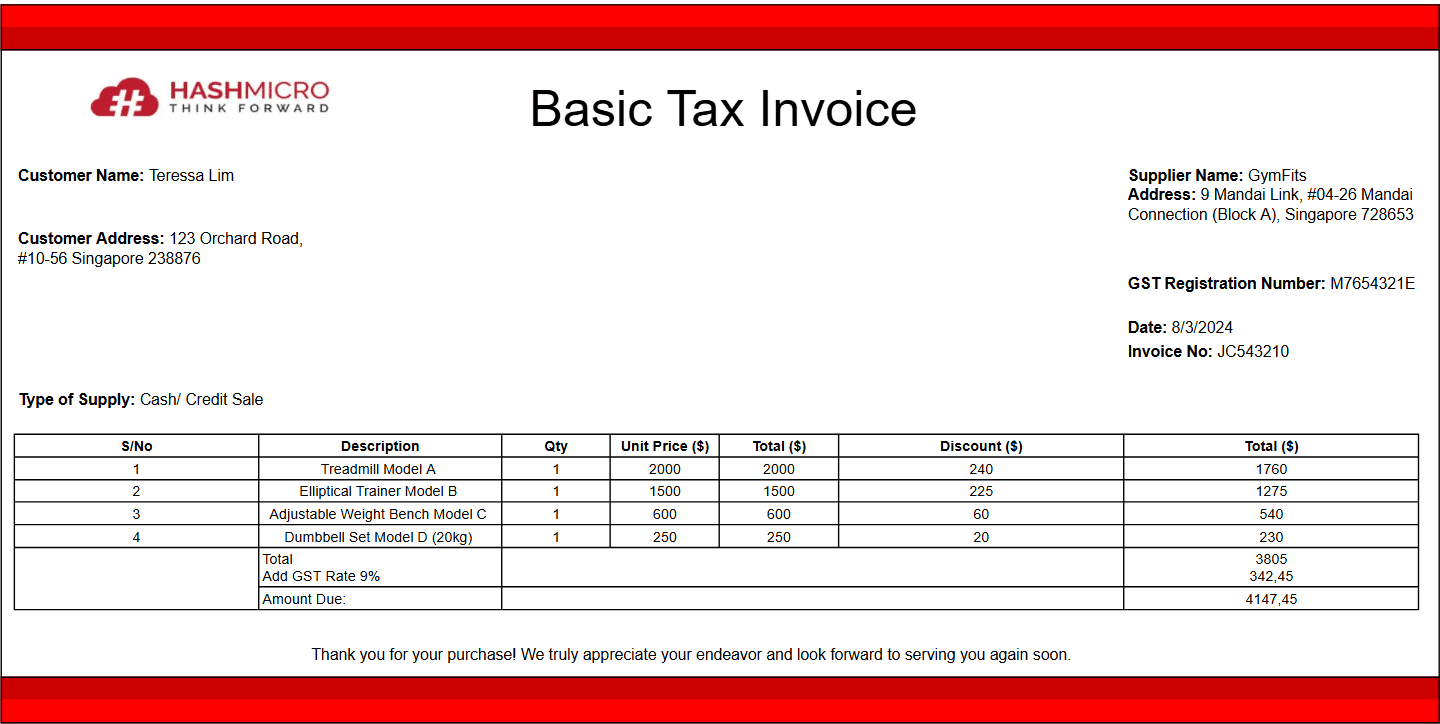

2. Project-based service tax invoice
Designed for businesses managing long-term or complex projects, this template provides a breakdown of project phases, milestones, and associated costs. It ensures transparency, making it easier for both parties to track progress and payments.
Project-Based Service Tax Invoice Template
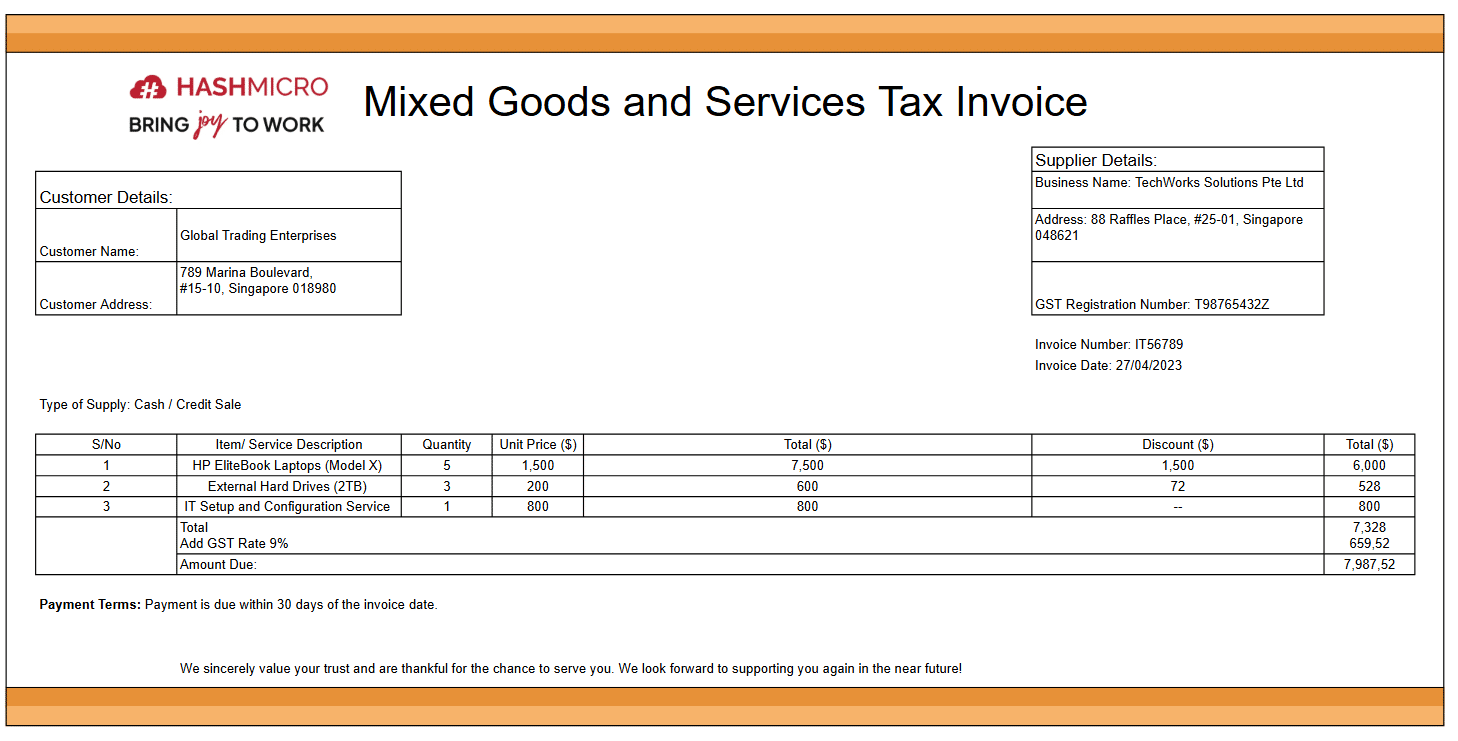

3. Mixed goods and services tax invoice
If your business offers both goods and services, this template is the perfect fit. It itemizes products and services separately, clearly showing quantities, rates, and GST calculations for each.
Mixed Goods and Services Tax Invoice Template


4. Goods-focused tax invoice
Tailored for businesses dealing primarily with physical products, this template highlights product details, including quantities, unit prices, discounts, and GST rates. It ensures customers receive a clear breakdown of their purchases.
Goods-Focused Tax Invoice Template
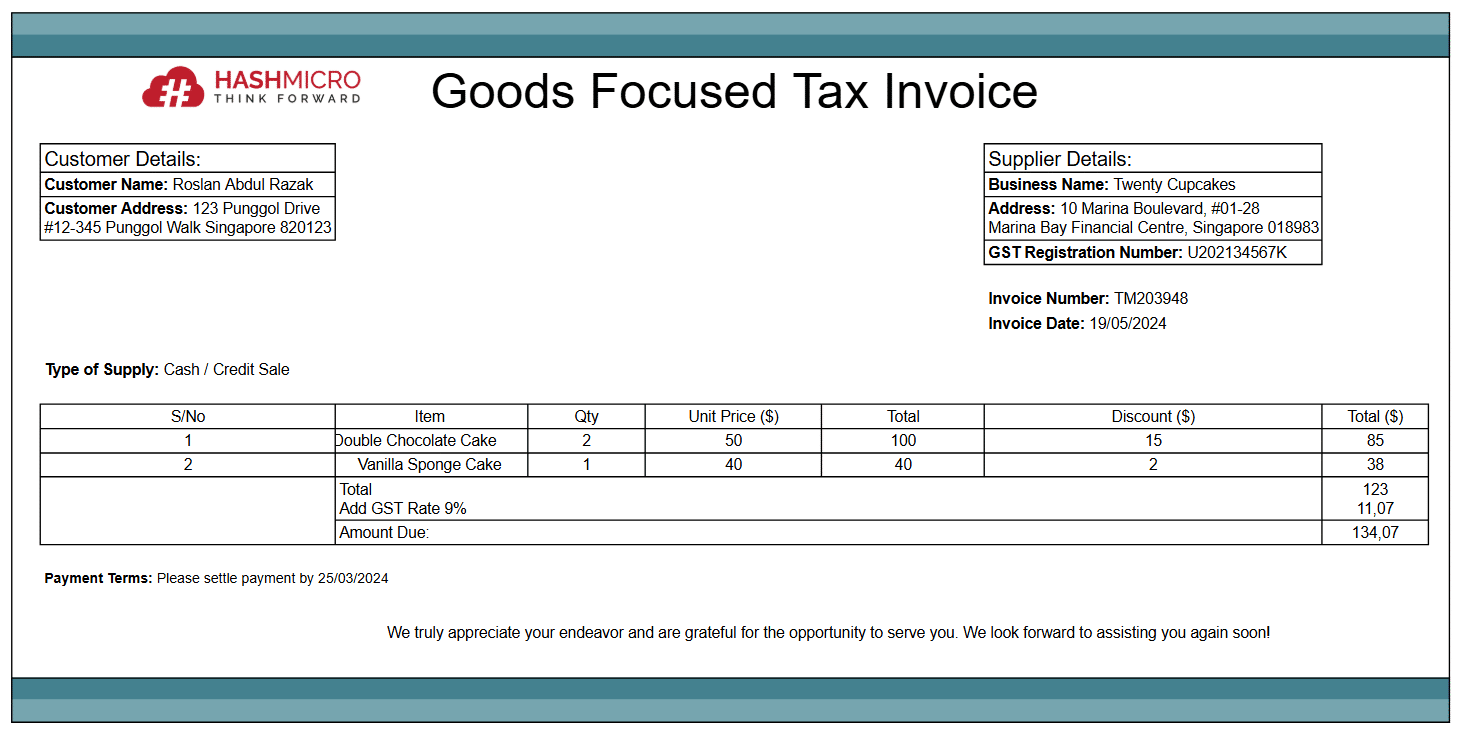

5. Services tax invoice
This template is ideal for businesses offering services. It outlines the scope of work, hours worked, rates, and GST calculations, ensuring clients have a detailed record of services rendered.
Service Tax Invoice Template
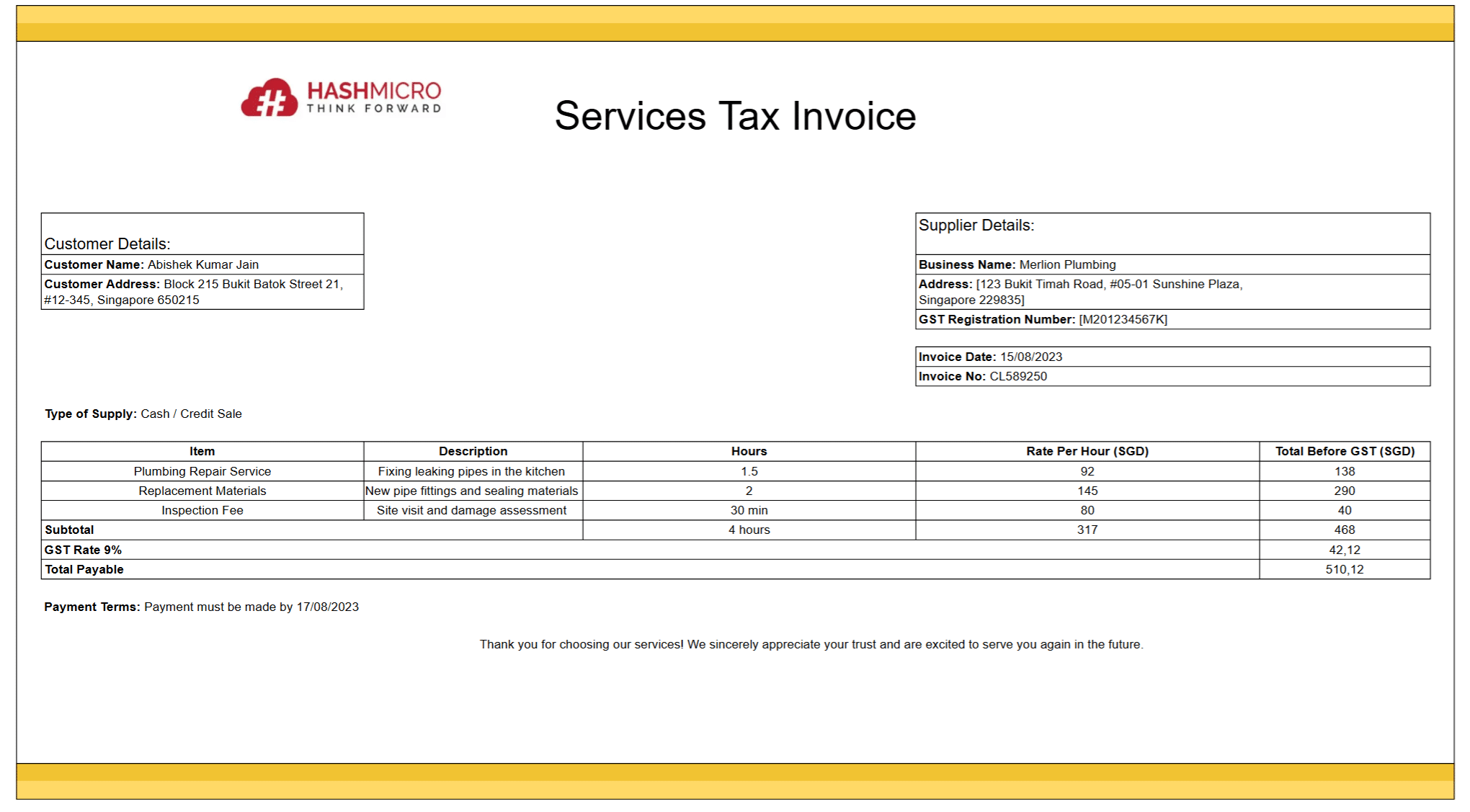

By using these tailored templates, businesses can simplify invoicing, maintain compliance with IRAS regulations, and build stronger customer relationships. Choose the one that suits your needs best!
What are the Differences Between Tax Invoice vs Receipt?
A tax invoice and a receipt both play key roles in business transactions, but they serve different purposes and contain distinct information. A tax invoice is issued before payment is made, detailing the transaction, including the GST breakdown, the supplier’s name, and the amount payable.
It is essential for GST-registered businesses, as it provides the necessary documentation for tax claims and reporting. This document ensures businesses stay compliant with IRAS regulations, making it a vital part of the sales process.
On the other hand, a receipt is issued after the payment has been completed. Its primary function is to confirm that the transaction has been settled, serving as proof of payment. Unlike a tax invoice, a receipt is generally simpler, listing only the amount paid and the payment method, without the need for GST details.
While both documents are important, understanding the difference between them helps businesses manage their financial records more accurately and ensures smooth transactions with customers.
What are the Challenges of Using a Tax Invoice Template?
Businesses face several challenges when using tax invoice templates, especially around accuracy and compliance. Missing details, such as incomplete invoice information or incorrect GST registration numbers, can result in non-compliance with IRAS regulations.
Manual data entry also increases the risk of errors, which may lead to miscalculations or inconsistencies. Adapting to evolving tax laws is another concern. Static templates often fail to keep up with changes, such as the upcoming InvoiceNow mandate on November 1, 2025.
Generic templates may also lack the customization needed to capture industry-specific details, creating gaps in compliance and functionality. Efficiency can be hindered when templates lack automation features, like real-time tax calculations or sequential numbering.
Additionally, many templates don’t integrate easily with accounting software or ERP systems, leading to time-consuming manual updates and synchronization issues. Finally, traditional templates pose challenges for record keeping. Businesses often struggle with storage and retrieval, especially for physical invoices, during audits or GST returns.
As Singapore transitions to mandatory e-invoicing, shifting to digital solutions will be crucial for ensuring compliance and streamlining invoicing processes.
How HashMicro E-Invoicing Software Can Help and Become the Best Solution for Your Company?
As businesses in Singapore face challenges in managing tax invoice templates, such as ensuring data accuracy, keeping up with evolving tax regulations, and streamlining integration with accounting systems, the need for a more efficient, compliant, and automated solution has never been more critical.
These issues can lead to costly errors, delays, and compliance risks. However, HashMicro’s e-Invoicing Software is specifically designed to tackle these pain points and offer comprehensive solutions.
-
Data Accuracy and Completeness
Businesses often struggle with manual errors in tax calculations and missing invoice details. With HashMicro’s e-Invoicing Software, you no longer need to worry about these issues. The system automates tax and discount calculations, ensuring that every invoice is accurate, complete, and compliant with IRAS regulations. This minimizes the risk of penalties and ensures your invoicing process runs smoothly.
-
Compliance and Adaptability
As tax laws evolve, traditional templates become outdated and may no longer meet the necessary requirements. HashMicro’s e-Invoicing Software keeps pace with changes in tax regulations, including the upcoming InvoiceNow mandate. This built-in adaptability guarantees that your invoices will always comply with the latest requirements, providing peace of mind and reducing the need for manual updates.
-
Efficiency and Integration
Time-consuming manual tasks, like sequential numbering or real-time tax calculations, can slow down operations. HashMicro’s system automates these functions, freeing up your time to focus on other areas of your business. Furthermore, it integrates seamlessly with accounting software and ERP systems, ensuring smooth data synchronization and reducing manual entry errors.
-
Record Keeping and Retrieval
Storing and retrieving physical copies of invoices can be a hassle, especially during audits or GST returns. HashMicro’s digital invoicing system centralizes your records, making it easy to access and manage invoices at any time. This not only improves operational efficiency but also helps during audits, as all necessary documentation is readily available.
-
Future-Proofing Your Business
With the upcoming mandatory e-invoicing system, businesses need to be prepared for the shift. HashMicro’s e-Invoicing Software is already aligned with the InvoiceNow system, allowing your business to transition smoothly without the risk of falling behind. By adopting this solution now, you future-proof your invoicing process and avoid potential disruptions in the coming years.
This is why HashMicro’s e-Invoicing Software is the ideal solution to streamline your invoicing processes, improve accuracy, and ensure compliance. By implementing this software, businesses in Singapore can overcome common invoicing challenges and position themselves for future success.
Conclusion
Tax invoices are essential for compliance with GST regulations in Singapore but managing them manually can be time-consuming and prone to errors. Using tax invoice templates simplifies the process, saving time and reducing mistakes.
However, they may still fall short as tax laws evolve and systems need integration. To overcome these challenges, HashMicro’s e-Invoicing Software offers an automated, efficient solution that ensures accuracy, compliance, and seamless integration with accounting systems.
It helps businesses stay ahead of regulatory changes and streamlines invoicing processes for better efficiency. We encourage you to try our free demo and discover how HashMicro can simplify your invoicing and improve your business operations.
Let us help you enhance your business efficiency and stay compliant, effortlessly.



